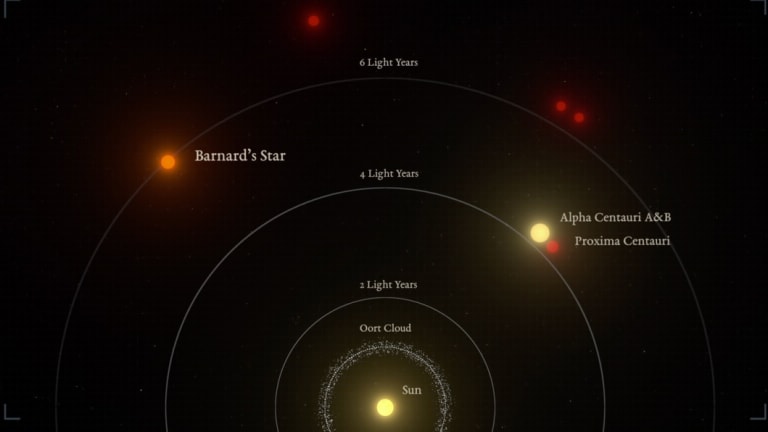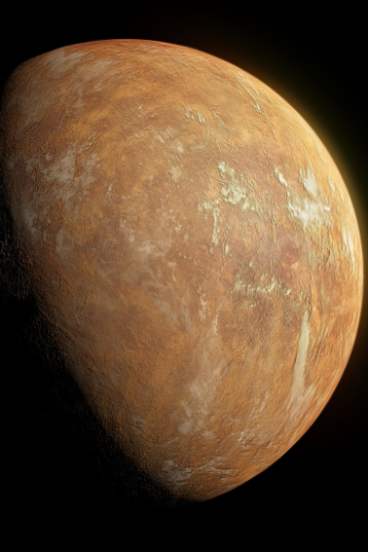
The newly discovered world, described in the journal Nature on Wednesday, is associated with a small, dim star known as Barnard's Star that is older than our solar system. It takes the planet 233 days to complete a single orbit around its cool red sun.
The planet around Barnard's Star is probably too cold to host life with surface temperatures of perhaps minus 170 degrees Celsius, researchers said.

An illustration of the relative distances to the nearest stars from our sun. Barnard's Star is the second closest star system.Credit:Guillem Ramisa/IEEC/Science Wave
Although it is about as close to its own star as Mercury is to our sun, scientists say it is probably as cold as Saturn. That's because Barnard's Star provides the frigid planet with only 2 per cent of the energy that the sun provides Earth.
But the new discovery is exciting for other reasons.

An artist's impression of the "super-Earth" planet that orbits Barnard's Star, whose light casts an orange tint. Credit:Guillem Ramisa/IEEC/Science Wave
The proximity of the newly found planet to Earth makes it an excellent target for future observations. It is so close that the next generation of telescopes may be able to image it directly, the researchers said.
In addition, the new find provides further evidence that planets are nearly ubiquitous around red dwarf stars, said Ignasi Ribas, an astronomer and director of the Institute of Space Studies of Catalonia in Spain, who led the work.
"The chances of finding new ones is quite high," he said.
The new detection was made by a team of scientists working on an astronomy collaboration called Red Dots. Together, they are scanning the night sky for planets orbiting nearby dim red dwarf stars. Ultimately they hope to find a world in the habitable zone of these stars, where liquid water could pool on its surface.
The only closer known planet is an Earth-sized body that orbits the small red star Proxima Centauri in the Alpha Centauri triple-star system. That planet was discovered in 2016 and lies just four light-years from Earth.
This is not the first time that astronomers have thought they had found a planet around Barnard's Star.
Back in the 1960s Peter van de Kamp, a Dutch astronomer based in the United States, reported the discovery of two planets roughly the size of Jupiter orbiting the red dwarf.
To come to this conclusion he used a technique called astrometry that measures the movement of a single star across the celestial sphere. The idea is that the gravity of a planet orbiting that star would cause the star to shift its position ever so slightly compared with more distant background stars.
Based on his observations, van de Kamp believed one of the planets completed a full orbit around the dim star in 12 years, while the other completed its orbit in 20 years.
Loading
However, as astrometry measurement techniques became more precise, scientists found that the supposed signals of Van de Kamp's two planets did not exist after all.
The new discovery of a single, much smaller planet orbiting Barnard's Star is based on a different observational technique called radial velocity.
In this method scientists use spectrometers to look for a small wobble in the light from the star that would indicate it has a planet orbiting around it.
"A light source that comes towards us would have its wavelength slightly blue shifted, while a light source that moves away from us has its wavelength slightly red shifted," Ribas said.
The magnitude of the wobble reveals the minimum mass of the planet that is responsible for the motion.
The radial velocity method was developed in the 1990s and has been steadily improving ever since, Ribas said. Even so, the size of the newly found planet is just on the edge of what current instruments can detect.
This particular discovery was possible only because the research team was able to examine hundreds of measurements that had been made over 20 years, he said. That gave them enough data to detect the small signal of the planet.
To ensure the detection was accurate, the authors also observed Barnard's Star every possible night during 2016 and 2017 from the Calar Alto Astronomical Observatory in Spain. A clear signal at a period of 233 days arose again and again.
Rodrigo Diaz, an astronomer at the University of Buenos Aires who was not involved in the new work, said that, while the findings are promising, he'd still like to see more evidence of the new planet's existence.
"Difficult detections such as this one warrant confirmation by independent methods and research groups," he said in an essay accompanying the new study.
The European Space Agency's Gaia Space Observatory may be able to make detections that would further confirm the presence of a planet around Barnard's Star, he said, but those data aren't expected to be released until the 2020s.
Martin Kurster an astronomer at the Max Planck Institute for Astronomy who worked on the new study, said it is possible that the detection of the new planet could one day be disproved.
However, he thinks that the presence of the planet is currently the best interpretation of the data the team has collected so far.
"It could be that a different explanation for the observational evidence we have will be found in the future," he said. "But I don't think that is likely to happen."
Los Angeles Times, Reuters









 Add Category
Add Category